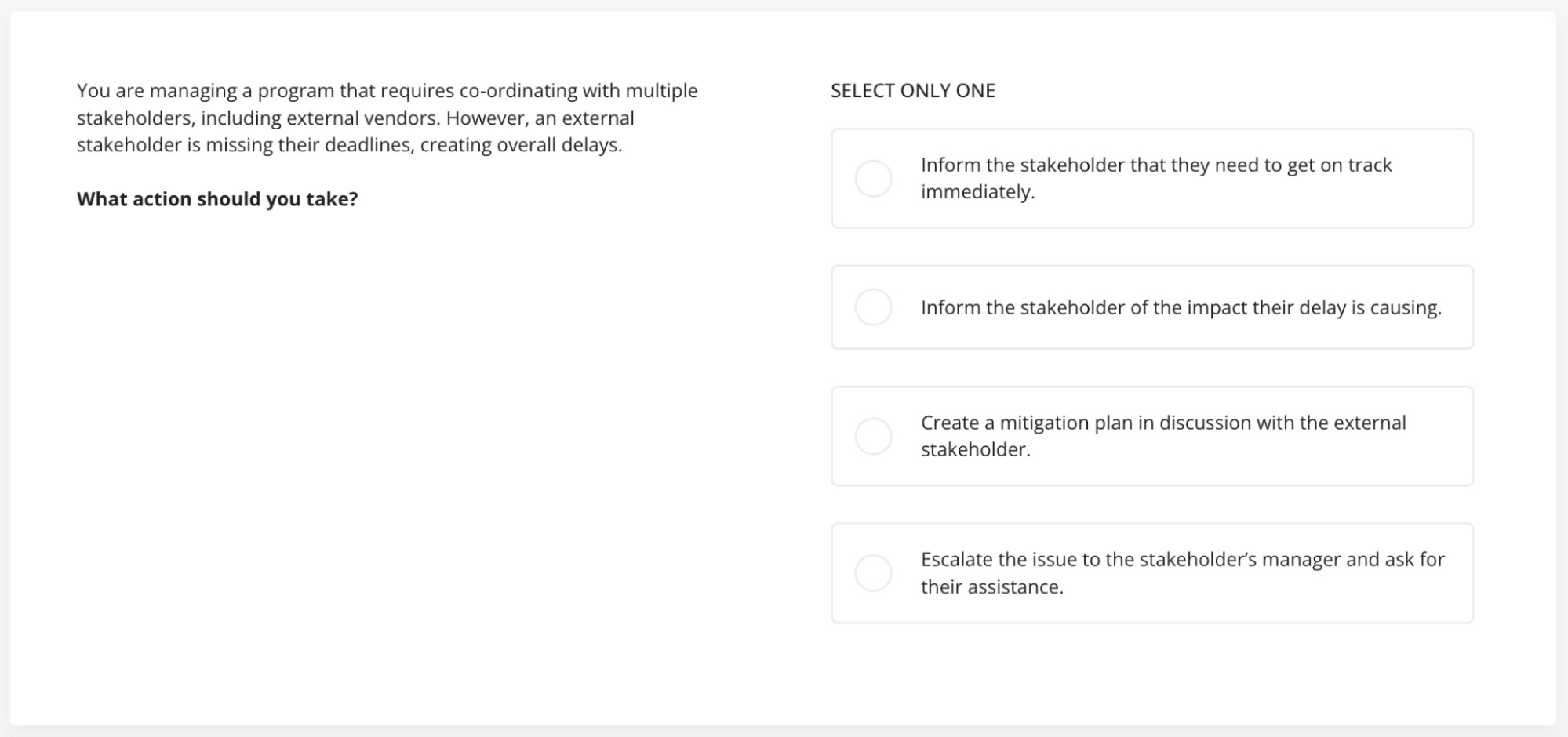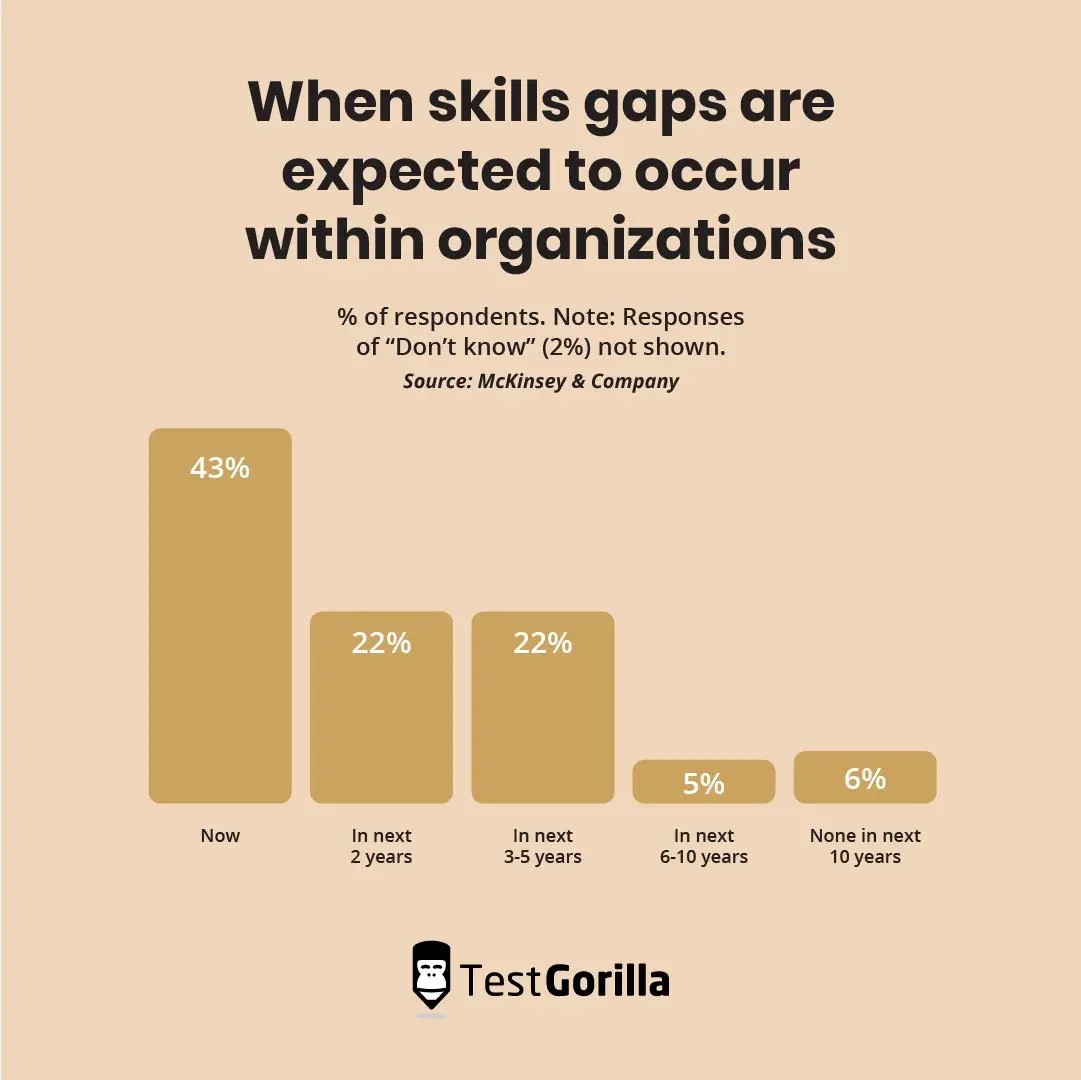“How do I lay off an employee gracefully?”
It’s nearly universal that laying off employees is the toughest part of being an HR manager. Research conducted by Fortune shows that layoffs are one of the main contributing factors to manager anxiety.
It’s a delicate process. If you don’t handle it properly, layoffs can damage your corporate reputation and demotivate your employees.
On top of this, your laid-off workers are human beings with emotions, and the layoff process already has an emotional impact on them, even when handled delicately.
Here are our seven tips on how to lay off employees while remaining an attractive workplace.
How to lay off employees with dignity | Description |
Use talent assessments to map your workforce | Discover your necessary skills using data-driven skills tests |
Build a comprehensive plan for laying off employees | Determine communication plans, incentives, and how many employees are necessary for the transition |
Ensure your company uses consistent criteria when it lays off employees | Use hard data to fuel your layoff decisions, easing layoffs and avoiding discrimination |
Practice transparent communication while laying people off | Discuss when layoffs are occurring and who’s involved so you don’t hurt employee engagement |
Hold a meaningful layoff notification meeting | Schedule personal meetings with the affected employees and use compassionate language |
Provide outplacement services | Offer outplacement services to support laid-off employees and maintain your reputation |
Offer incentives for staff to stay for the full transition period | Consider incentivizing staff with severance bonuses if they stay their full period |
More details follow shortly.
What is a layoff?
An employee layoff is a permanent or temporary termination of an employee’s contract for reasons unrelated to their performance, usually owing to organizational restructuring or reorganization. There are many reasons you could do this, including:
Economic downturns
Mergers and acquisitions
Relocating
Outsourcing
Layoffs are not uncommon. In 2022, the US tech sector alone shed 93,000 workers. These layoffs saturated the job market and overwhelmed hiring managers with applicants.
Layoffs can be necessary, but knowing how to lay off workers properly is difficult. Downsizing hurts nine out of 12 work conditions. Negative consequences include increased supervisor aggression, reduced relationships, and fewer promotion opportunities.
7 tips on how to lay employees off with dignity
Let’s answer this common question: “How do I lay someone off with respect?” by providing you with all the details on the seven tips we mentioned earlier.
They help you lay employees off with dignity, maintain working relationships, support worker wellbeing, and not burn any bridges.
1. Use talent assessments to map your workforce
When a company lays off employees, it’s critical to examine the expertise of each employee. A great way to ensure you retain key capabilities is by gauging employees’ skills using talent assessments.
Talent assessments help you objectively evaluate your workforce and find vital skills, giving you insights to identify the skills gaps contributing to your company’s poor performance.
For example, a SaaS company can use our Program Management test to discover it has a wealth of development capabilities but no project management expertise in its product team. This can help it lay off employees strategically and avoid creating talent gaps that must be plugged in the near future (a needlessly expensive option).
A sample question from our Program Management test – see more of this test.
Be sure to think carefully about your workforce’s skill sets because nearly 90% of companies worldwide are experiencing skills gaps or expect to experience one in the next few years. Identifying areas of weakness in your organization before layoffs is crucial to making the right choices and cutting costs without further damaging your productivity and ability to serve customers.
Skills-based hiring also protects you against workplace discrimination cases when re-hiring.
For example, a company may choose to lay off older employees and hire new, younger ones. Talent assessments can prove that this wasn’t discrimination and that these new workers have the required skills.
Learn more about talent assessments
Are you ready to learn more about talent assessments and how they help with hiring and laying off?
2. Build a comprehensive plan for laying off employees
Once you know which capabilities you need, build a solid plan before you begin laying people off.
First, consider your full workforce when cutting certain positions. Diversity is a top priority when making these decisions because people of color are especially vulnerable to layoffs. Once you know who you’re laying off, it’s important to detail and document how you’re going to do it.
Your plan for laying people off should include:
How to deliver the news
How many employees are necessary for the transitional period
Severance packages or outplacement services
Incentives for those who stay on longer
A plan maintains organization and clarity and keeps your team aligned on the strategy.
3. Ensure your company uses consistent criteria when it lays off employees
You must maintain fairness when laying people off to protect yourself from discrimination cases, lay off employees legally, and make the situation easier on your workers.
Using talent assessments helps you make unbiased decisions and promote transparency. It’s nearly impossible to provide objective proof without data-driven skills tests.
Communicate your criteria to employees and provide them with specific examples so they understand your decision was unbiased and necessary for business needs.
For example, you can use the data from a JavaScript Entry-Level test when laying off an employee to show them they lack crucial coding knowledge that the company requires to service its changing portfolio of customers.
If you’d like to learn more about talent assessments and how they help you objectively measure your workforce’s skills, don’t miss out on our product tour.
4. Practice transparent communication while laying people off
Waiting for layoffs can cause extreme anxiety in employees.
One researcher discovered the overwhelming stress employees went through during layoffs. These employees recalled watching their businesses announce layoffs without details and letting rumors circulate for months.
Learn how to lay off staff properly by practicing good communication. Let them know:
The reasons for the layoffs, including hard data if possible
Which departments are affected
When those affected learn their status
What support is available, and whom employees can talk to
However, you must strike a balance between direct and delicate.
A poor example of how to layoff an employee is how Vishal Garg, the chief executive of Better.com, did it. He received heavy criticism for abruptly laying off 900 employees on one Zoom webinar just before the holidays. Garg’s approach to mass layoffs lacked:
A personal touch: You can’t adequately connect with 900 people in one Zoom call
Depth: The call was described as “short and emotionless,” with little opportunity for employees to ask questions.
Tactful timing: Conducting layoffs right before major holidays shows little empathy and emotional intelligence
Clear communication is one of our tips for managing necessary attrition in our guide to improving the attrition rate.
5. Hold a meaningful notification meeting
Conduct face-to-face notification meetings where possible, enabling employees to ask questions and receive personal responses.
It’s tricky to know what to say when you give advance notice without sounding like you’re making small talk or are dismissive. If you were talking to a friend, you might try to empathize, but it isn’t helpful to your employee if you put the focus on yourself in the conversation:
Senior management common phrases | What employees hear |
“This is hard for me.” | “I’m the real victim here.” |
“It’s a scary time for everyone.” | “It’s not all about you.” |
“I hate seeing you like this.” | “Hide your emotions.” |
“I know this news is difficult, but…” | “I don’t have time to deal with your feelings.” |
Instead, simply say that you’re sorry.
Learning how to layoff an employee also includes proper timing for the worker and the remaining staff. When deciding when to hold these meetings, you should also consider existing worker adjustment.
Avoid scheduling a notification meeting before or after annual leave, the employee’s birthday, or other important dates, such as holidays or anniversaries.
Poorly timed meetings have a negative impact on retention and your remaining staff, regardless of whether you’re a small business or a corporation.
6. Provide outplacement services to support workers
Offering outplacement assistance softens the blow of being laid off and provides tangible support, similar to unemployment benefits.
Besides unemployment insurance, these services can include:
Resume writing
Job search support
Network
Career counseling
Information packages
Reference letters
You can also offer the cash equivalent of placements. Money can help former full-time employees until they find new employment and perks like health insurance.
Providing outplacement services helps you maintain your corporate reputation so stakeholders understand you support your people, even when it’s time to depart.
For more tips on handling departing employees gracefully, read our guide on involuntary turnover.
7. Offer incentives for staff to stay for the full transition period
Communicate the transition period to employees – this is the period when their employment is still in effect.
Most employees choose not to work during this period. However, offering incentives for employees to keep working until the end of their contract is a good idea. It can help you transfer responsibilities and ease the cultural transition for your remaining employees.
One important incentive you can offer is greater flexibility to staff, which helps them attend interviews for a new job. You can extend their severance package the longer they stay during the transition period.
We realize this might be a hard sell to your higher-ups, especially if your layoffs resulted from financial issues.
However, incentives are a good investment. This support improves employees’ and the public’s opinion of your organization, preserving its attractiveness to future hires, referrals, and potential rehires.
The best insights on HR and recruitment, delivered to your inbox.
Biweekly updates. No spam. Unsubscribe any time.
Know how to layoff an employee gracefully and improve your company
Learning how to lay off employees with dignity maintains solid relationships and your employer branding.
Laying off an employee with the right practices and tools isn’t painless, but these resources can make layoffs more precise, effective, and respectful of your employees.
Start by clearly understanding your employees’ skill sets with talent assessments, and follow up with clear communication across your entire workforce.
Book a demo with our experts today to learn more about the power of talent assessments and how they can ease organizational change.
You can also sign up for our Free Forever Plan, which gives you unlimited access to five skills tests, including communication and time management.
To learn the ins and outs of hiring the best candidates with talent assessments, take our product tour.
Laying off employees FAQS
How do you lay off an employee politely? What’s the difference between being laid off and fired? Let’s answer these frequently asked questions, plus five more.
What’s the difference between being laid off and being fired?
Companies do layoffs for reasons unrelated to an employee’s performance or behavior. On the other hand, businesses fire employees when they are underachieving on performance reviews, or their behavior does not align with the organization’s expectations. It’s necessary to be clear in your notification meeting whether staff is being fired or laid off and the specific grounds for their dismissal, which helps protect your business from legal challenges.
How do you politely lay off an employee?
Prepare all your data for the notification meeting
Schedule the meeting on a convenient date
Address all questions
Avoid making empty promises
Lay out the criteria used for your decisions
Offer the employee helpful resources
For more advice on how to lay off employees politely and with dignity, read our best practices above.
What is the proper way to conduct a layoff?
Discovering necessary skills objectively with talent assessments
Using this data to provide transparent communication to your employees
Holding a tactful notification meeting
Providing employees with helpful resources
Offering incentives to employees who stay for the transition period
Explore these tips in depth and learn how to lay people off earlier in this blog post.
How do you lay off a lot of employees?
Notify employees when as many of them as possible are in the office to announce the layoffs in person.
Ensure you notify employees early. Certain regions require large companies to notify employees 90 days in advance.
Prepare your HR tech stack to handle the severance agreement, final paychecks, and severance pay.
What does a layoff meeting look like?
A layoff meeting is usually a 30-minute meeting between an employee, a senior member of the team, and human resources. The senior teammate and HR professional discuss the layoff terms and criteria. The employee then receives an information package, benefits information, and a copy of their employment contract.
What not to say when laying someone off?
The main things not to say when laying someone off sound deceptively compassionate. Phrases like “Don’t take this personally” and “This could be a good opportunity for you” don’t show kindness to the employee and mainly help you feel better. Unfortunately, this is a tough time, and there isn’t much you can say to ease the burden beyond “I’m sorry.”
What is the best day to lay off employees?
Mondays, Tuesdays, and Wednesdays are ideal days for laying people off. It gives employees time to finish work and talk with HR and the legal department. We don’t recommend laying people off on Fridays because it may suggest to remaining workers that you wanted a full week of work out of their coworkers before laying them off.
Related posts
You've scrolled this far
Why not try TestGorilla for free, and see what happens when you put skills first.

















